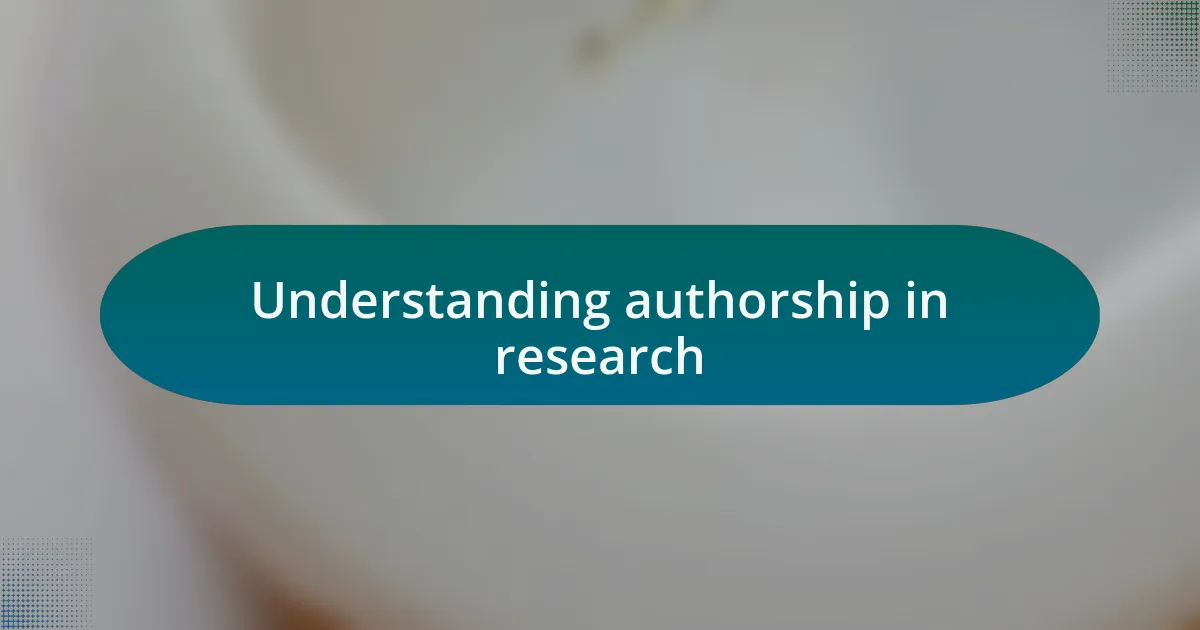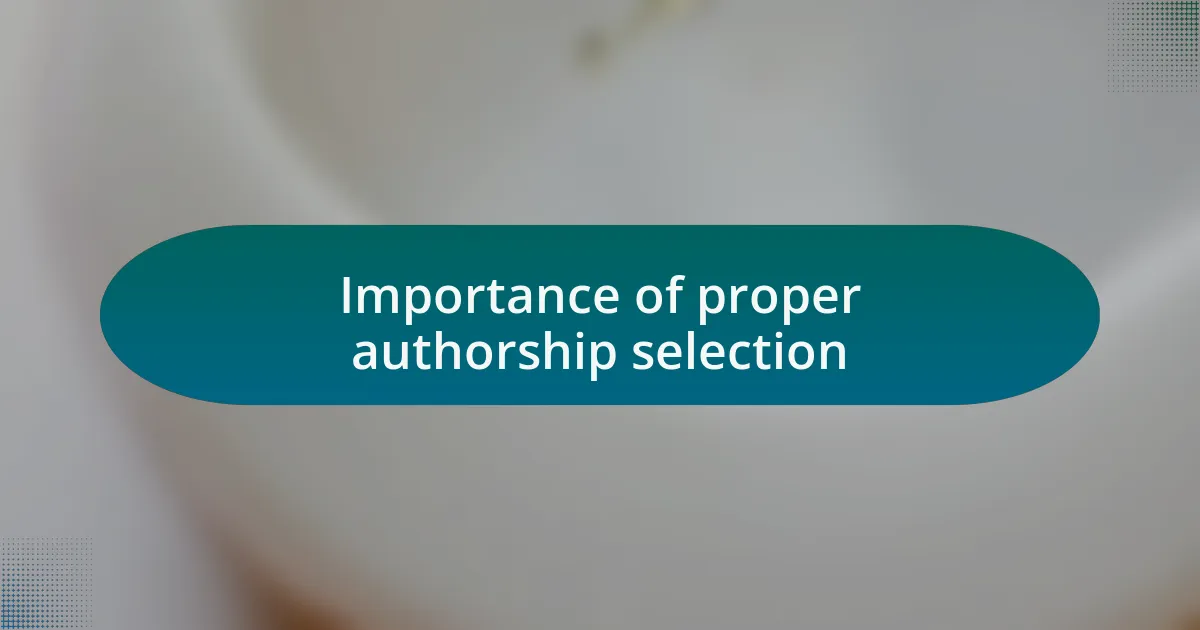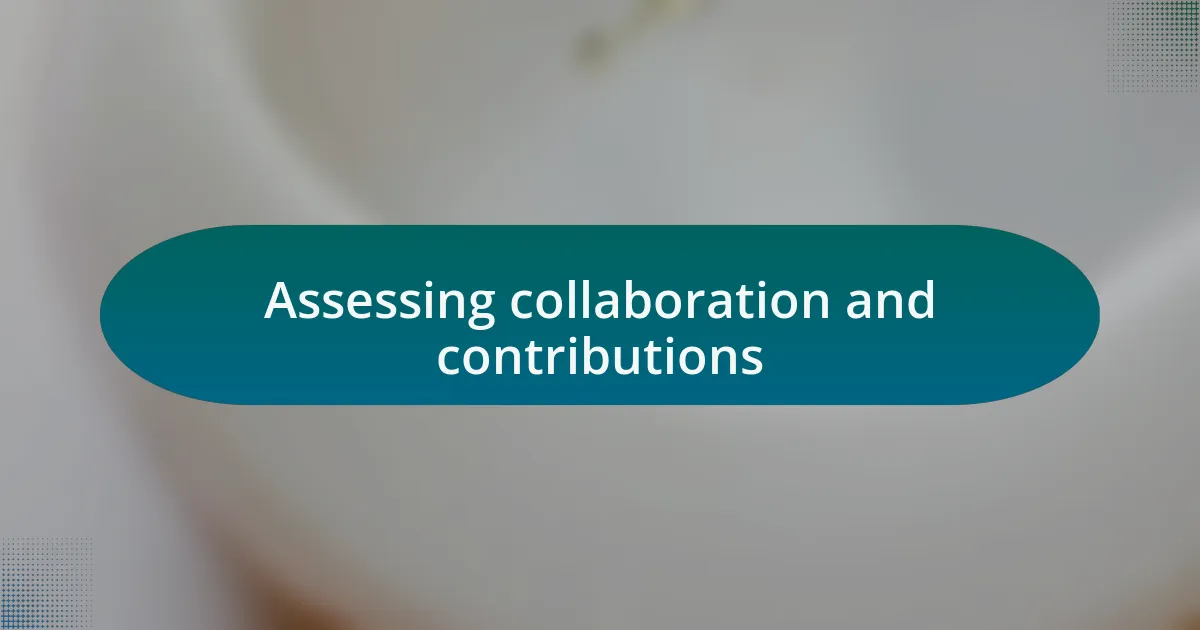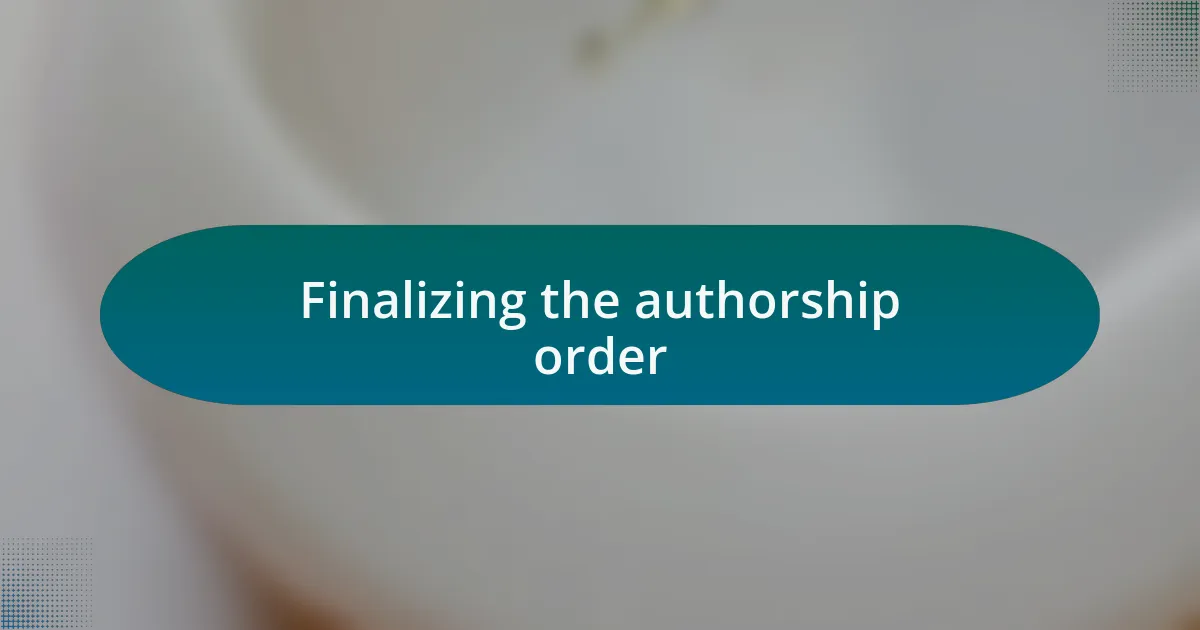Key takeaways:
- Authorship in research should be based on clear criteria established early, ensuring contributions are recognized and valued, which fosters collaboration.
- Proper authorship selection is crucial for team morale and impacts research visibility, requiring ethical considerations beyond hierarchical structures.
- Evaluating potential authors should include assessing their contributions, expertise, and communication skills, while also recognizing the value of diverse perspectives within the team.
- Effective communication about authorship expectations throughout the research process is essential to maintaining clarity and respect for each member’s contributions.

Understanding authorship in research
Authorship in research is more than just a name on a paper; it represents significant contributions to a project. I remember a time when I was part of a collaborative study, and the discussions about who should be listed as authors felt like navigating a minefield. It made me realize how essential it is to set clear criteria for authorship early on, ensuring that everyone’s contributions are acknowledged and valued.
It’s fascinating to think about how different disciplines have varying standards for authorship. In my experience, some fields emphasize intellectual contributions, while others might focus on technical tasks or data collection. This disparity can lead to confusion and, at times, conflict. Have you ever found yourself in a situation where your contributions felt underestimated? It’s crucial to communicate openly about expectations and to respect the norms of your specific research community.
Establishing authorship criteria can help avoid disputes and foster a sense of collaboration among team members. I’ve found it helpful to create a written agreement outlining everyone’s roles and contributions at the project’s onset. This not only clarifies responsibilities but also sets a positive tone, reinforcing the idea that acknowledgment in research is about honoring each person’s effort and passion.

Importance of proper authorship selection
Selecting the right authorship is critical because it impacts not just the recognition of contributions, but also how the research is perceived in the wider academic community. I recall a particularly enlightening moment during a project where improper authorship led to someone feeling excluded and disheartened. It made me realize that authorship issues can affect team morale and even future collaborations; the respect we show amongst ourselves sets the groundwork for trust and productivity.
Another aspect to consider is the ethical responsibility that comes with authorship. I have seen projects where authorship was awarded simply based on hierarchical position, which sparked resentment among those who had invested significant effort. It made me think, how can we hold ourselves accountable to the integrity of our research if we overlook contributions? Each author should not only be recognized but also be able to defend their role ethically, ensuring the work reflects collective credibility.
Furthermore, proper authorship selection influences the visibility and impact of the research. In my own journey, when I was correctly listed as an author on a high-impact publication, it opened doors for further opportunities and collaborations. Have you ever thought about how a missed opportunity for authorship could have altered your academic trajectory? It truly shows that the implications of authorship extend far beyond a name on a paper; they can shape careers and foster a spirit of unity in scholarly exploration.

Key criteria for selecting authors
When selecting authors for a scientific research project, one of the key criteria I consider is the level of contribution each individual has made. I’ve often found that the most insightful ideas can come from early-stage researchers who might not yet have the titles of their more experienced counterparts. This calls into question: are we valuing contribution or simply the title associated with the person? Reflecting on my earlier experiences, I vividly remember a project where a junior team member brought in a breakthrough idea. Recognizing that contribution in authorship not only validated their efforts but also enriched the overall research.
Another essential criterion is the expertise that each author brings to the table. For instance, during a collaborative study, I encountered an instance where a fellow researcher had unique statistical skills. I still remember the moment when they helped us interpret complex data that ultimately shaped our conclusions. Would we have reached those insights without their expertise? I don’t think so. This highlights that a diverse skill set enhances the quality of research and should be a major factor when determining authorship.
Finally, the stability of involvement throughout the project is crucial. I recall a project where a last-minute inclusion of an author led to confusion over contributions and created tension within the team. It’s a concern I frequently ponder: how do we ensure that every author is genuinely involved and invested in the work? It underscores the importance of establishing clear roles and maintaining consistent communication; that way, we can avoid the pitfalls that arise from miscommunication and ensure every author genuinely contributes to the research.
Evaluating potential authors’ expertise
Evaluating an author’s expertise requires a thoughtful assessment of their previous work and contributions. In my experience, I once reviewed a potential author whose publication history showcased deep knowledge in a niche area that aligned perfectly with our project’s objectives. This made me wonder: how often do we overlook someone because their past work is not in the limelight, yet their expertise could be exactly what we need?
Another layer to consider is the practical experience an author brings. I had a colleague who had spent years in the lab before transitioning to academia. Their firsthand experiences not only informed our findings but also enriched team discussions with real-world context. I often ask myself, how can we truly gauge someone’s capabilities without looking beyond their resumes?
Moreover, I pay close attention to how authors communicate their ideas. I’ve collaborated with researchers who could articulate complex concepts clearly and persuasively, making a difference in how our collective work was perceived. Effective communication is a skill that often gets underrated; I sometimes catch myself thinking, “Could a brilliant mind fail to shine because they lack this essential ability?” This emphasizes the need to evaluate not just knowledge, but how that knowledge is shared within the team.

Assessing collaboration and contributions
When it comes to assessing collaboration, I’ve found that looking beyond just individual merits is essential. I recall one research project where the potential authors had varied skills, but their collaborative spirit was the real game-changer. It made me reflect: how often do we ignore the chemistry between team members, assuming technical skills alone will drive success?
Contributions can manifest in unexpected ways. During a recent project, a junior researcher suggested an innovative approach to data analysis that none of us had considered. This experience reminded me that sometimes the most valuable insights come from those who are less experienced but bring fresh perspectives. How do we ensure that every voice is heard, especially when power dynamics might overshadow the quieter contributors?
In my experience, I’ve realized that recognizing contributions goes beyond just quantifying input; it’s about understanding the nuances of team dynamics. Collaborating with someone who is not only knowledgeable but also genuinely invested in the collective goal creates a richer research environment. I often wonder, are we truly valuing the emotional investment that fosters collaboration, or are we merely tallying the number of papers authored?

Communicating authorship expectations
Communicating authorship expectations is a vital part of any collaborative research project. I remember a time when I was part of a study group, and we had an open discussion about who was going to be listed as authors. Being upfront about our contributions helped clear the air and set clear expectations, which ultimately simplified the writing process. It really got me thinking: how often do we skip this conversation, assuming everyone is on the same page?
In practice, I’ve found it effective to establish authorship criteria early on. For instance, in one project, I created a simple framework outlining potential contributions for authorship, which included roles like conceptualization, data collection, and writing. This not only ensured everyone understood their responsibilities but also highlighted the importance of each contribution, regardless of its size. I ask myself, how much smoother would things go if every team had such a list from the start?
Moreover, I continuously emphasize the need for ongoing dialogue about authorship throughout the research process. I’ve noticed that as projects evolve, so do the roles of team members. By revisiting authorship expectations during meetings, I believe we foster an environment where everyone feels valued. It raises an important question: if authorship doesn’t reflect the true contributions of all involved, who benefits in the long run?

Finalizing the authorship order
Finalizing the authorship order requires careful consideration of each contributor’s role and impact on the project. I remember a situation where we had to make some tough decisions about authorship after intense discussions. We laid out our contributions on a visible chart and realized that some might have contributed significantly but were hesitant to claim credit, which led me to ponder: how do we ensure everyone feels represented in this important placement?
In my experience, it’s not just about who did the most work; it’s also about ensuring that the authorship order reflects the narrative of the research. For instance, in a recent project, we decided to prioritize the person who initially proposed the research idea, honoring their vision. This brought up an interesting discussion: should the first author always be the one who contributed the most data, or does the intellectual leadership hold different weight?
Ultimately, I believe the authorship order should encourage collaboration and respect contribution size and visibility. I’ve found that a transparent approach makes it easier to finalize the order. However, I can’t help but ask myself, how do we strike the right balance between fairness and recognition? Addressing this question has made me appreciate the nuances of academic collaboration even more.